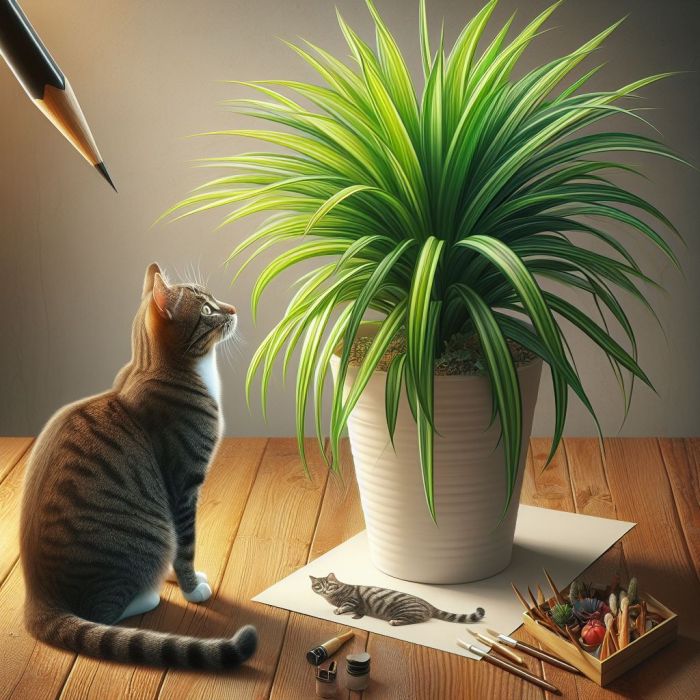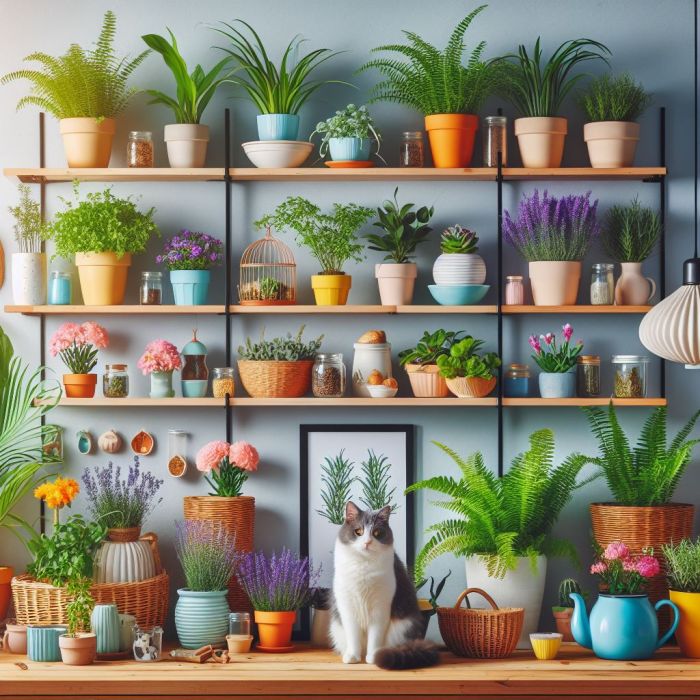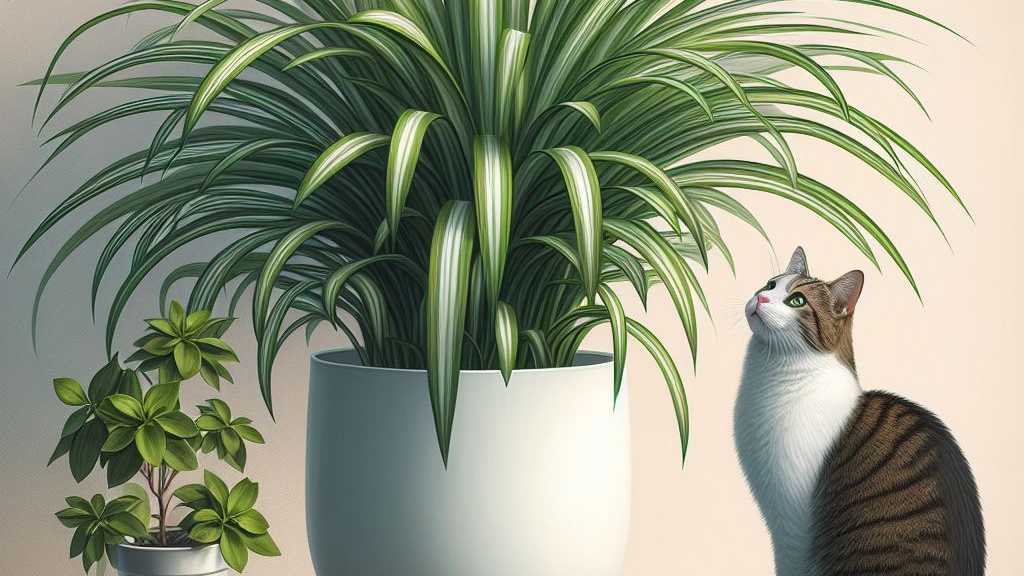Last updated on September 16th, 2024 at 07:07 am
Spider plants (Chlorophytum comosum) are popular, low-maintenance houseplants cherished for their ornamental foliage and air-purifying properties. Known for their ability to thrive in various conditions, spider plants are favored by both novice and seasoned plant enthusiasts. These plants are characterized by their long, slender leaves that often have a central stripe of white or cream, adding a touch of elegance to indoor spaces.
Contents
- 1 Are spider plants toxic to cats and dogs?
- 2 Symptoms of Spider Plants Poisoning
- 3 Actions to Take if Your Pet Ingests a Spider Plant
- 4 Non-Toxic Alternatives for Pet Owners
- 5 FAQS
- 5.1 1- Are spider plants poisonous to cats and dogs?
- 5.2 2- What are the common signs of spider plant poisoning in pets?
- 5.3 3- How can I prevent my pets from accessing spider plants?
- 5.4 4- What are some safe alternatives to spider plants for pet-friendly households?
- 5.5 5- How do I care for non-toxic plants in a household with pets?
- 5.6 6- Can spider plants and pets coexist safely in the same household?
- 6 Author
Are spider plants toxic to cats and dogs?

These resilient plants, with their adaptability to diverse environments, including low-light conditions, further contribute to their widespread appeal among indoor gardeners.
Are spider plants toxic to cats and dogs? Despite their aesthetic appeal and ease of care, pet owners are cautious due to the potential toxicity these plants might have on their furry companions.
Understanding the relationship between spider plants and pet health is crucial for responsible pet ownership. This concern prompts pet owners to seek information and guidance to ensure a safe environment within their households where both plants and animals coexist harmoniously.
Symptoms of Spider Plants Poisoning

1- Mild Symptoms
Pet owners often observe mild symptoms in their cats or dogs after suspected ingestion of spider plant foliage, raising questions about ‘Are spider plants toxic to cats and dogs?
When pets ingest spider plant leaves or sap, they may exhibit mild symptoms that could indicate poisoning. These can include gastrointestinal upset such as vomiting and diarrhea. Additionally, some animals might display excessive drooling or mild lethargy. These initial signs, while concerning, are often indicative of the body’s attempt to expel the ingested substances.
2- Severe Symptoms
Understanding the severity of potential reactions becomes crucial in addressing concerns related to ‘Are spider plants toxic to cats and dogs?’ as severe symptoms could pose significant threats to the health of pets.
In more severe cases of spider plant ingestion, pets might display intensified symptoms, signaling a potentially serious situation. These severe signs could encompass difficulty breathing, severe vomiting or diarrhea, tremors, or even seizures. Furthermore, some animals might exhibit noticeable weakness or loss of coordination.
Actions to Take if Your Pet Ingests a Spider Plant
Facing the distressing scenario of a pet ingesting a spider plant raises immediate concerns for pet owners. The question of whether ‘Are spider plants toxic to cats and dogs?’ becomes a pivotal point of worry. Knowing how to respond swiftly and effectively in such situations is vital for ensuring your pet’s well-being. Here’s a comprehensive guide outlining the necessary steps to take if your pet ingests a spider plant, offering essential guidance to address this pressing concern.
1- Assess the Situation
If you witness or suspect that your pet has ingested any part of a spider plant, remain calm but act promptly. Remove your pet from the plant to prevent further ingestion.
2- Observe Symptoms
Monitor your pet closely for any symptoms of poisoning, ranging from mild (vomiting, diarrhea) to severe (difficulty breathing, seizures). Take note of the time of ingestion and any visible symptoms.
Prompt action is crucial if there’s a suspicion of ingestion, raising concerns about ‘Are spider plants toxic to cats and dogs?’ Immediate observation and assessment help in determining the appropriate steps.”
1- Contact a Veterinarian

Immediately contact your veterinarian or an emergency veterinary service. Provide them with details about the plant ingested, the amount, and any observed symptoms. Follow their guidance carefully.
Contact Information:
2- Veterinary Assistance
Have your veterinarian’s contact number readily available. In case of emergency after-hours, keep contact information for the nearest 24-hour veterinary clinic or emergency animal hospital.
3- Poison Control Centers
Keep the contact information for the ASPCA Animal Poison Control Center or a local poison control center accessible. They can provide specific guidance for pet poisoning emergencies.
Remember, swift action and seeking professional help are vital if your pet ingests any part of a spider plant. This proactive approach can significantly aid in ensuring your pet receives the necessary care in case of ingestion or poisoning.
Non-Toxic Alternatives for Pet Owners
Pet-Friendly Plant Options

In addressing concerns about spider plants’ potential toxicity to cats and dogs, it’s essential to present safe indoor plant alternatives. Pet owners seeking greenery that poses no harm to their furry companions may consider several non-toxic plants. Some excellent alternatives include the Boston fern, African violet, or select species of palms and succulents. Offering these alternatives assures pet owners of safe choices and provides peace of mind, directly addressing concerns about ‘Are spider plants toxic to cats and dogs?’
Benefits and Maintenance
Highlighting the advantages of these non-toxic alternatives serves to reassure pet owners about their plant choices. These pet-friendly options not only contribute to indoor aesthetics but also aid in purifying indoor air. Moreover, emphasizing their ease of care and maintenance ensures pet owners that they can foster a green environment without compromising their pets’ safety, effectively mitigating worries about the potential toxicity of spider plants to cats and dogs.
By offering insights into safe indoor plant alternatives and emphasizing their benefits and simplicity in care, pet owners can confidently select non-toxic indoor plants, ensuring a harmonious environment for their pets and cultivating a vibrant living space for both plants and animals.
FAQS
1- Are spider plants poisonous to cats and dogs?
Yes, spider plants (Chlorophytum comosum) are listed as non-toxic to cats and dogs by the ASPCA (American Society for the Prevention of Cruelty to Animals). However, mild gastrointestinal upset may occur if ingested in larger quantities.
2- What are the common signs of spider plant poisoning in pets?
Pets might display mild symptoms such as vomiting, diarrhea, or mild lethargy after ingesting spider plant leaves. In severe cases, symptoms can escalate to difficulty breathing, severe gastrointestinal distress, tremors, or seizures.
3- How can I prevent my pets from accessing spider plants?
Place spider plants in areas that are inaccessible to pets or use deterrents such as bitter sprays to discourage chewing. Consider opting for pet-friendly plants as alternatives to ensure your pet’s safety.
4- What are some safe alternatives to spider plants for pet-friendly households?
Several pet-safe indoor plants can be considered, including the Boston fern, African violet, or select species of palms and succulents. These alternatives provide non-toxic greenery, ensuring a safer environment for pets.
5- How do I care for non-toxic plants in a household with pets?
Non-toxic plants like Boston ferns or African violets require regular watering, proper light exposure, and occasional fertilization. Ensure the plants are placed out of reach of curious pets to prevent ingestion.
6- Can spider plants and pets coexist safely in the same household?
With proper precautions and awareness, spider plants can often coexist safely with pets. However, monitoring and preventing access to plants, along with considering non-toxic alternatives, are advisable for a pet-safe environment.
In addressing the question “Are spider plants toxic to cats and dogs?” it’s important to note that while spider plants are generally considered non-toxic to pets, caution is advised. Recognizing potential symptoms of ingestion and having a swift response plan, including contacting a veterinarian if needed, is crucial.
Exploring non-toxic plant alternatives like the Boston fern or African violet offers pet owners peace of mind. Responsible pet ownership involves creating a safe environment where pets and plants coexist harmoniously. By staying informed and taking proactive measures, pet owners can ensure a secure and vibrant space for their pets and indoor greenery.


2 thoughts on “Are Spider Plants Toxic to Cats and Dogs?”
Comments are closed.